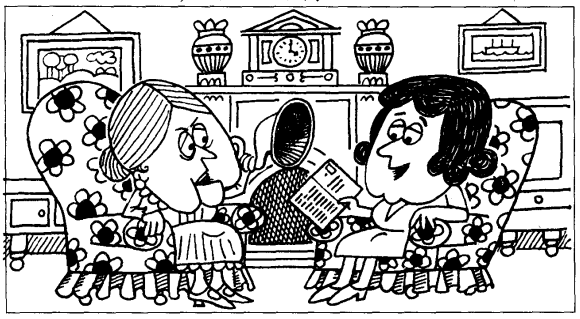one|Lesson 101~110
Lesson 101~102
✨课文

✨单词
反意疑问句
⚡本课重点
反意疑问句:用来询问某种情况是否真实,或者别人是否同意自己。它的组成分为两部分:逗号前面为主句,后面为反意疑问句。在口语中,逗号后的问句可以用right?代替
当前面是肯定句时,后面就是否定句,「前肯后否」
e.g. Sally can speak French, can't she?
当前面是否定句时,后面就是肯定句,「前否后肯」
e.g. Sally can't speak French, can she?
其特点为:
- 问句的主语和主句的主语一致
- 前后的助动词一致
- 前后的时态一致
在语调上的区别:
- 升调:表示疑问,期待对方回答
- 降调:表示确定,不需要回答
Lesson 103~104
✨课文

✨单词
⚡本课重点
程度副词:too > very > enough
too:用于表示程度时,其意思为「太、过于」
可以用在
too adj.(+for sb.)+to V. sth.结构中e.g. This skirt is too big for me.、The wall is too high for me to climb.、She is too young to live alone.
enough:单词本义为「足够」
在形容词之后使用,
adj.+enough(+for sb.)+to V.e.g. He failed the exam because it wasn't easy enough.、She is old enough to get married.、This question is easy enough for me to answer.
在名词之前使用
e.g. We don't have enough money.
可以用在
enough ... for sb./sth.或enough ... to V. sth.结构中e.g. e.g. She hasn't got enough money for a holiday.、She isn't old enough to live alone.、There isn't nearly enough time to get there now
could:can的过去式,用法和can几乎一样,具体参考43~44课
hate to do sth.:讨厌做某事(一次性的)
hate doing sth.:讨厌做某事(经常性的)
Lesson 105~106
✨课文

✨单词
⚡本课重点
动词不定式:具体参考87~88课
be full of:一种习惯用法,表示「充满」
- e.g. He is full of energy.、Your story is full of mistakes.
want to do sth.:想要做某事,在口语中,常常把want to说成wanna,即wanna do sth.
- e.g. I want to buy a new car. => I wanna buy a new car.
tell sb. to do sth.:告诉某人做某事
- e.g. Please tell him to bring me some coffee.
Lesson 107~108
✨课文

✨单词
比较级和最高级
⚡本课重点
形容词的比较级和最高级:以er结尾的形容词属于「比较级」,而以est结尾的形容词属于「最高级」
其变化规则如下
①一般情况下,单音节形容词的词尾直接加
er/este.g. small => smaller => smallest、new => newer => newest
②以
e结尾的形容词,直接在词尾加r/ste.g. nice => nicer => nicest、large => larger => largest
③以辅音字母加
y结尾的形容词,将y改为i,再加er/este.g. easy => easier => easiest、heavy => heavier => heaviest
④当单音节形容词只有一个元音字母,并且以一个辅音字母结尾时(往往以重读闭音节的形式出现,即
辅元辅),先双写词尾辅音字母再加er/este.g. big => bigger => biggest、thin => thinner => thinnest
⑤不规则变化
e.g. good/well => better => best、bad/ill => worse => worst、little => less => least、many/much => more => most
⑥大多数较长的形容词(即有两个以上音节的词)可与
more/less连用构成比较级,与most/least连用构成最高级e.g. She's more beautiful than her sister.、She's the most beautiful in her class.
用法:
比较级只用于两者之间,通常与
than连用,结构为主语+be+adj.er+than+比较对象。如果所指代事物很明确,也可以独立存在e.g. He's taller than his father.、I haven't got a larger dress.
最高级用于三者或以上的情况,在使用时必须加定冠词
the,并常伴有一个表示范围的介词短语或从句,其常见结构如下主语+be+the+adj.est(+n.)+范围e.g. That girl is the tallest student in our class.
主语+be+the+adj.est(+n.)+I've ever V.pp.e.g. This is the craziest thing I've ever done.
排除自己:使用
othere.g. He's taller than any other students in his class.、Shanghai is larger than other cities in China.
would:will的过去式,表示「愿意」。常常与like连用构成would like,缩写形式为'd like
would like+n.:愿意尝试某物/事e.g. I would like some tea. = I'd like some tea.
would like+to do sth.:愿意做某事e.g. I would like to help him.
Lesson 109~110
✨课文

✨单词
⚡本课重点
不可数名词的多与少,用much和little来表达;可数名词的多与少,用many和few来表达。在之前的79~80课中学习了much和many的用法,本节课来学习little和few
little:单词本义为「一点、少许」
a little+un.:表示肯定含义,即剩余的数量刚好够完成接下来要做的事e.g. There is a little milk in the fridge. You can drink that.、They have a little money, so they're not very poor.
little+un.:表示否定含义,即剩余的数量不足以完成接下来要做的事e.g. There is little milk in the fridge. We need to buy some.、They have little money. They're very poor.
few:单词本义为「几个」
a few+cn.:表示肯定含义e.g. There are a few apples in the basket.、I've got a few friends, so I'm not lonely.
few+cn.:表示否定含义e.g. There are few apples in the basket. It's nearly empty.、I've got few friends. I'm sad and lonely.
had better do sth.:最好做某事
advice sb. to do sth.:建议某人做某事